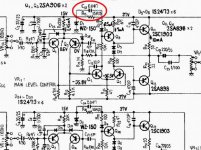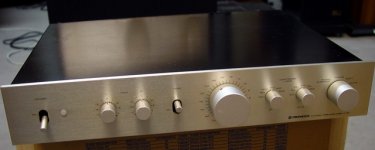SY said:You're right, we don't want AC there, but for the sake of PSR, whatever IS there should be equal on both sides of the dropping resistor.
I would have assumed the opposite - that one wouldn't want any ac components due to the output stage current draw to affect the input. In fact i have tried supplying the input differential from its own regulator and always liked the result. The capacitor is a bit too small for most audio frequencies anyway. Same as Carlos i am baffled.
I go along with analog_sa and Jan. This is only a guess, building on Jan's comment. Maybe putting it across that R is a cost-saving trick. It still serves as bypass at hi-freq (well, above 2 kHz or so) as it sees an AC ground on the low voltage side but Pioneer can use a lower voltage cap. I know it sounds crazy but maybe there were a few accountants on the design team. I've seen equally goofy tricks in scientific instrumentation when the accountants made the engineers design to a price-point.
I've seen equally goofy tricks in scientific instrumentation when the accountants made the engineers design to a price-point.
 I've seen equally goofy tricks in scientific instrumentation when the accountants made the engineers design to a price-point.
I've seen equally goofy tricks in scientific instrumentation when the accountants made the engineers design to a price-point.The pré amplifier is a famous model...something considered high end for the eigthies
and i can see a simple circuit.... the difference is that condenser...this makes me very curious.
You know.... this starts a kind of thinking.
"Maybe this capacitor has something with that quality achieved by the model....."
Because there are capacitors into the audio patch that can "open"..or turn "wider" the channel separation.... turning sound stage awsome....so... a single capacitor can make a difference.
Pioneer C21 is the preamplifier.
regards,
Carlos
and i can see a simple circuit.... the difference is that condenser...this makes me very curious.
You know.... this starts a kind of thinking.
"Maybe this capacitor has something with that quality achieved by the model....."
Because there are capacitors into the audio patch that can "open"..or turn "wider" the channel separation.... turning sound stage awsome....so... a single capacitor can make a difference.
Pioneer C21 is the preamplifier.
regards,
Carlos
Attachments
I have a Krill to finish too... i have sent to a friend to do it for me
as i was very sick....and he is delaying a lot.
He is busy... and i cannot ask the unit back to debug because he is sensitive and will feel ofended.
aaagh!.
this way nothing moves!
he is having off set (16V) into the output.... some error made.
I will not solder this weekend.... too much lazy to do that and it is cold here (ahahahaha!.... 26 degrées celsius!)
Also my daugther is at home with me.... i am just eating, doing nothing and surfing into the internet... beeing curious and producing questions.
regards,
Carlos
.................................................................................................
Do not even try to read the vineger name... strangers cannot pronunciate the "NH"..... sounds alike the Italian food pronunciation... Ignochi... Italian Gn sounds alike NH in portuguese.
as i was very sick....and he is delaying a lot.
He is busy... and i cannot ask the unit back to debug because he is sensitive and will feel ofended.
aaagh!.
this way nothing moves!
he is having off set (16V) into the output.... some error made.
I will not solder this weekend.... too much lazy to do that and it is cold here (ahahahaha!.... 26 degrées celsius!)
Also my daugther is at home with me.... i am just eating, doing nothing and surfing into the internet... beeing curious and producing questions.
regards,
Carlos
.................................................................................................
Do not even try to read the vineger name... strangers cannot pronunciate the "NH"..... sounds alike the Italian food pronunciation... Ignochi... Italian Gn sounds alike NH in portuguese.
Attachments
I think it is either stability-related or a way to balance the PSRR. I've often seen caps in very strange positions in amps and then when you remove them it oscillates or hums or whatever. Very often put in after the prototype release because they won't spend the time and money to re-do the whole layout and physical construction. So most probably it won't show up in sim (or if it shows up, the wrong way around).
But the cap is rather high, true.
Jan Didden
But the cap is rather high, true.
Jan Didden
I agree, however it's not the first time I see decoupling made to either +Vcc or -Vee and not to Gnd as commonly seen....I think it is either stability-related or a way to balance the PSRR. I've often seen caps in very strange positions in amps and then when you remove them it oscillates or hums or whatever.
Maybe the only way to test is is to built the circuit and make some tests
Yes... to build is the solution... i will not.
too much lazy those rainy days..for us it is cold..a good weather to take a nap..to sleep whole afternoon.
Exercising the rigth to do absolutelly nothing.
Everybody lazy around those rainy days... saturday is when people enter restaurants to eat a lot..all day eating and having beer.... even police is lazy..watch the way those guys have parked their car.
regards,
Carlos
too much lazy those rainy days..for us it is cold..a good weather to take a nap..to sleep whole afternoon.
Exercising the rigth to do absolutelly nothing.
Everybody lazy around those rainy days... saturday is when people enter restaurants to eat a lot..all day eating and having beer.... even police is lazy..watch the way those guys have parked their car.
regards,
Carlos
An externally hosted image should be here but it was not working when we last tested it.
Jukebox for ya friends!
From the eighties!
enjoy friends.
regards,
Carlos
http://www.tropicalglen.com/Jukebox/80-84Top/myjukebox.swf
From the eighties!
enjoy friends.
regards,
Carlos
http://www.tropicalglen.com/Jukebox/80-84Top/myjukebox.swf
Attachments
Current to zener is too much small... observe resistance is 15K
and the differential is draining half of that.
This may have switching noises...noises when zener goes on and off when voltage is reduce by the power consumption into the output stage .... maybe the capacitor is there because of that...it is strange.
This was something Klaas Veenstra show me to think about...he is not sure..also i am not sure.
regards,
Carlos
.............................................
Musics from the fifties:
http://www.tropicalglen.com/Jukebox/50-54Top/myjukebox.swf
From 1955 to 1959:
http://www.tropicalglen.com/Jukebox/55-59Top/myjukebox.swf
From 1960 to 1964:
http://www.tropicalglen.com/Jukebox/60-64Top/myjukebox.swf
From 1970 to 1974:
http://www.tropicalglen.com/Jukebox/70-74Top/myjukebox.swf
From 1980 to 1984:
http://www.tropicalglen.com/Jukebox/80-84Top/myjukebox.swf
From 1985 to 1989:
http://www.tropicalglen.com/Jukebox/85-89Top/myjukebox.swf
All those musics are perfect to DIY testing... reason why offered to folks to use.
and the differential is draining half of that.
This may have switching noises...noises when zener goes on and off when voltage is reduce by the power consumption into the output stage .... maybe the capacitor is there because of that...it is strange.
This was something Klaas Veenstra show me to think about...he is not sure..also i am not sure.
regards,
Carlos
.............................................
Musics from the fifties:
http://www.tropicalglen.com/Jukebox/50-54Top/myjukebox.swf
From 1955 to 1959:
http://www.tropicalglen.com/Jukebox/55-59Top/myjukebox.swf
From 1960 to 1964:
http://www.tropicalglen.com/Jukebox/60-64Top/myjukebox.swf
From 1970 to 1974:
http://www.tropicalglen.com/Jukebox/70-74Top/myjukebox.swf
From 1980 to 1984:
http://www.tropicalglen.com/Jukebox/80-84Top/myjukebox.swf
From 1985 to 1989:
http://www.tropicalglen.com/Jukebox/85-89Top/myjukebox.swf
All those musics are perfect to DIY testing... reason why offered to folks to use.
- Status
- This old topic is closed. If you want to reopen this topic, contact a moderator using the "Report Post" button.
- Home
- Amplifiers
- Solid State
- Do you know what this capacitor is doing there?



